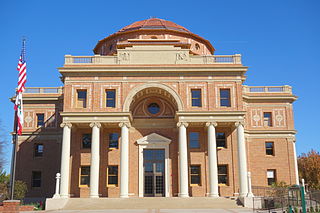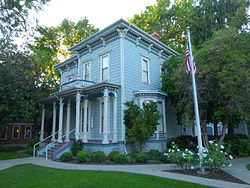
San Luis Obispo County, officially the County of San Luis Obispo, is a county on the Central Coast of California. As of the 2020 census, the population was 282,424. The county seat is San Luis Obispo.

Atascadero is a city in San Luis Obispo County, California, United States, located on U.S. Route 101. Atascadero is part of the San Luis Obispo-Paso Robles metropolitan statistical area, which encompasses the extents of the county. Atascadero is farther inland than most other cities in the county, and as a result, usually experiences warmer, drier summers, and cooler winters than other nearby cities such as San Luis Obispo and Pismo Beach. The main freeway through town is U.S. 101. The nearby State Routes 41 and 46 provide access to the Pacific Coast and the Central Valley of California.

San Luis Obispo is a city and county seat of San Luis Obispo County, in the U.S. state of California. Located on the Central Coast of California, San Luis Obispo is roughly halfway between the San Francisco Bay Area in the north and Greater Los Angeles in the south. The population was 47,063 at the 2020 census.

Russian Hill is a neighborhood of San Francisco, California. It is named after one of San Francisco's 44 hills, and one of its original "Seven Hills".

The Point San Luis Lighthouse, also known as the San Luis Obispo Light Station, is on the National Register of Historic Places. Located near Avila Beach and Port San Luis on the Central Coast of California in San Luis Obispo County, it is the only Prairie Victorian model lighthouse left on the West Coast of the United States. It is being refurbished by the Point San Luis Lighthouse Keepers, a volunteer group.

San Luis Obispo station is an Amtrak intercity rail station in the city of San Luis Obispo, California, United States. It has one side platform and one island platform serving the two tracks of the Coast Line.

On Wong, more commonly known as Ah Louis, was a Chinese American banker, labor contractor, farmer, and shopkeeper in San Luis Obispo, California, during the late 19th and early 20th century. He was remembered as “the unofficial mayor of Chinatown" for his community work.

Horton Grand Hotel is a restoration of two historic hotels, the Grand Horton and the Brooklyn Kahle Saddlery, in downtown San Diego, California. The Horton-Grand was added to the National Register of Historic Places in 1980.

This is a list of the National Register of Historic Places listings in San Luis Obispo County, California.

The Pereira Octagon Barn of San Luis Obispo is a historic structure located on the southern outskirts of San Luis Obispo, California. It was built in 1906 by Henri LaFranchi, a young Italian-Swiss immigrant and the owner of a small meat market, John Damaso, an Azorean immigrant and a carpenter by trade, and a third, unknown man identified only as a “milk farmer.” Since there were no other octagonal barns in the area, the builders may have worked from patterns of octagonal construction in farm journals or catalogs.

There are nine historic districts in Meridian, Mississippi. Each of these districts is listed on the National Register of Historic Places. One district, Meridian Downtown Historic District, is a combination of two older districts, Meridian Urban Center Historic District and Union Station Historic District. Many architectural styles are present in the districts, most from the late 19th century and early 20th century, including Queen Anne, Colonial Revival, Italianate, Art Deco, Late Victorian, and Bungalow.

The Myron Angel House is a historic house located at 714 Buchon St. in San Luis Obispo, California. Built circa 1880, the house has a vernacular design which does not follow a particular architectural style. The two-story wood-frame house has redwood siding, a shingled gable roof, and some Eastlake details in the window surrounds and gable ends. The house was once the home of Myron Angel, the main figure in the establishment of California Polytechnic State University. Angel, who lived in the house from 1889 to his 1911 death, proposed and lobbied for the creation of a polytechnic school in California; it was mainly due to his campaign that Cal Poly was founded in San Luis Obispo. In addition to his educational activism, Angel was also an influential journalist and historian.

The San Luis Obispo Carnegie Library is a Carnegie library located at 696 Monterey St. in San Luis Obispo, California. The library building was funded by the Carnegie foundation in 1903 and built in 1905; it housed the city's subscription library program, which had operated since 1894. William H. Weeks, who designed 21 Carnegie libraries in California, designed the San Luis Obispo library in the Richardsonian Romanesque style. The library's design includes a tall hipped roof with two gabled wings, decorations including gargoyles in the gable ends, and an entrance portico with multiple round arches. The building is mainly faced in red brick with yellow sandstone trim, but the basement is faced in dark gray granite.

The Powerhouse is a historic building located on the California Polytechnic State University campus in San Luis Obispo, California. Built from 1909 to 1910, it is the oldest building still standing at Cal Poly.
Myron W. Angel (1827-1911) was a historian and journalist who led efforts to found California Polytechnic State University in San Luis Obispo, California.
Walter Danforth Bliss (1874-1956) was an American architect from California. Many of his buildings are listed on the National Register of Historic Places.

The Tribune-Republic Building is a historic building located at 1763 Santa Barbara Street in San Luis Obispo, California.

The King–McBride Mansion, at 26-28 S. Howard St. in Virginia City, Nevada, is a historic Italianate-style house that was built in 1876, not long after the "Great Fire" in October, 1875. Also known as King House, it was listed on the National Register of Historic Places in 1998.

The South Royalton Historic District encompasses the central portion of the village of South Royalton, Vermont. Now the town of Royalton's principal commercial center, it developed in the second half of the 19th century around the depot of the Vermont Central Railroad. The district includes fine examples of Greek Revival and Victorian architecture, and is home to the Vermont Law School. It was listed on the National Register of Historic Places in 1976.
The City of San Luis Obispo Historic Resources consists of buildings and sites designated by the City of San Luis Obispo, California, as historic resources.





















